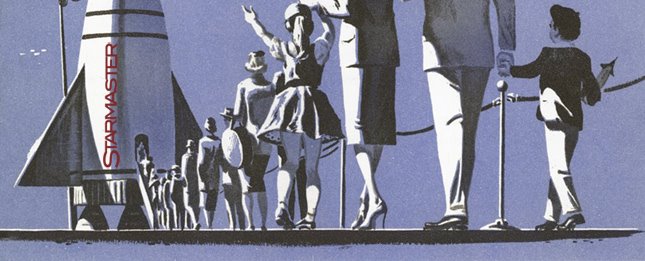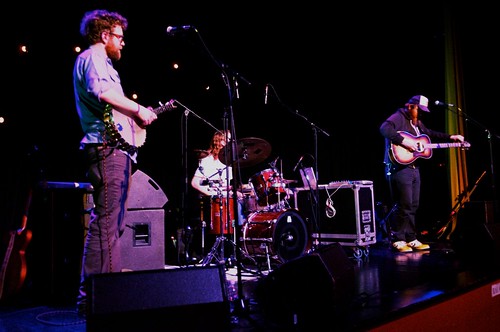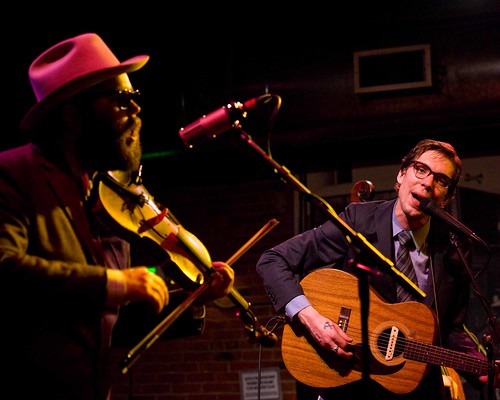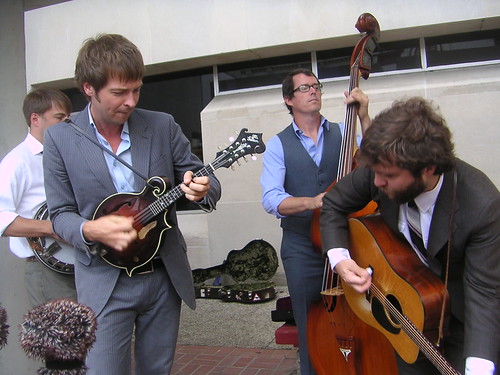 By Jon Stone
By Jon Stone |
@jwstone -
September 13, 2010
I moved to Champaign-Urbana three years ago hoping against hope that the town would have something resembling a music scene. For all I knew, it was going to be quiet cornfields with infrequent trips to Chicago every now and then to get my live music fix. Within weeks of my arrival posters for a festival called
Pygmalion showed up plastered around campus with Andrew Bird as the headliner. It’s become a yearly tradition ever since.
Pygmalion is a gift for our little indie-rock town/s. It happens early in the school year in that moment between the swelter and snow (September 22-25). It spreads out across Champaign and Urbana highlighting the best venues but always moving into unique spaces as well (last year Low played in a church and My Brightest Diamond played in an art gallery). And year after year it is literally packed with amazing acts.
This year is no different. Well, actually it is a little bit different. This year there’s been a bit of drama and confusion about headliners and schedules. The headliner was first announced to be pioneering garage/psychedelic 60s artist
Roky Erikson backed by
Okkervil River. And, indeed, Erickson will play Saturday night of the fest in the typical headliner location, the beautiful
Krannert Center for the Performing Arts. But Roky and Okkervil River have since been trumped on the Pyg concert poster by later festival additions,
of Montreal and
Built to Spill who will both play Wednesday the 22nd, the opening night of the fest.
In my view, however, too many good headliners is a great problem to have, and is the sign of a healthy festival. Organizer Seth Fein has been very
forthcoming about the difficulties of booking a fest like Pyg. At first there were some really difficult-to-swallow scheduling conflicts (Built to Spill/of Montreal)– especially that first night, but Seth and his team have now tweaked the schedule so headliners can all be seen without (too much) overlap. This is also a good thing. Check out the full schedule
here.
The best thing about a festival like Pygmalion is the chance to check out a ton of great new bands. I’ve spent the last few weeks going through the line-up, spending time on bands’ MySpace and homepages, paying attention especially to bands I’m less familiar with. So as a preview, I thought that rather than just regurgitating praise for the solid grouping of top-billed artists – the headliners,
Caribou,
Ted Leo & the Pharmacists, and
Surfer Blood among them – I’d prepare a list of mostly-new-to-me bands that have stood out as I’ve been doing my homework. So here goes:
Those Darlins: I'm cheating on the "less familiar" bit right off. I've seen Those Darlins before but if you haven't, you gotta. When the lineup was announced earlier this year, Those Darlins was the band I was happiest to see on it. I love this band -- I caught them on a whim when they came through town last winter, but the impression they left with their raucous country tunes and insatiable energy has lasted a long time. It will be great to see them again.
Janelle Monae: This one is also a bit of a cheat. Who hasn't heard of Janelle Monae? I realize of Montreal is a big deal -- Ryan here at Muzzle of Bees is a big fan -- but I'm more excited about opener Janelle Monae and I know I'm not alone. Monae's "Tightrope" and her enigmatic debut record
The ArchAndroid aren't just good, they are
smart, and I look forward to see how she brings it on the opening night of the festival. If there's anyone who can upstage the un-upstagable of Montreal, maybe she can.
The Cults - Speaking of enigmatic, all the internets offer up by way of sampling for this New York boy/girl duo is a bandcamp page. Pitchfork says they're "film students" -- I suspect they are playing up this mystery thing. The three songs you can download on that bandcamp page are great though, and if rocous country shenanigans aren't your cup of whiskey, be sure to check out The Cults who play, tragically, right when Those Darlins do.
Cap'n Jazz: Preeminent emo-before-it-was-cannibalized Chicago natives Cap'n Jazz have reunited. They are amazing. And I've only listened to them on their MySpace page.
+/- {plus/minus}: I have a weak spot for bands who can mix electronic beats and acoustic instruments well. +/- do. I'm less fond of bands who make themselves difficult to write about by their weird band names. So +/- kind of equal themselves out. (Could this be the implicit message in their band name? We'll never know.) I'm interested, though, in seeing what these dudes can pull off live. I'll be at their show.
Colour Revolt: Jackson, Mississipi gives us Colour Revolt. Their post-Pavement approach is wordy and the lyrics had me going
"did they just say...? why yes, yes they did. Wow" on several tracks. Looking forward to checking these guys out and not only just to find out what that British u is doing in their name.
Gold Motel - There are tons of great female artists playing Pygmalion this year, and the
Hush Sound's Greta Morgan's solo project Gold Motel is up there on my list of must-sees. This was one of the few artists who, once I landed on their MySpace page during my little study session, I didn't leave until I'd listened to every song there.
(Speaking of amazing women artists, I should add that I'm also interested in seeing the band Psychic Twins, a new project featuring Erin Fein of
Headlights.)
The Viper & His Famous Orchestra - Listen to this band for three seconds and you'll feel the pangs I'm feeling related to their scheduled performance time: right during headliners Roky Ericksen and Okkervil River. I have this hunch that one day (and I hope it's not far), bands with a bit of jazzy flare will get more appreciation in the indie crowd. Until then, I will listen to my
Preservation Hall compilations and
Bad Plus records and wish The Viper's orchestra was famous enough to not get scheduled right during the festival's headliner. (Let me insert here that I am not one of the out-of-shape-bent folks known to complain on certain CU blogs. I just like tappin' my feet as much as I like bobbin' my head is all.)
Zach May & the Maps - See above. I put together this list before I did things like check schedules. Zach May plays right before the Viper, but I still think he and his Maps have a great thing going. They're a little Beirut-y -- but well within the three-fourths of Beirut that I really like. So, if you don't want to throw down the big bucks for the Saturday night shows at Krannert, head over to Mike & Molly's for the evening. Cover is sure to be cheap, and the music will give those headliners a run for their money.
I haven't mentioned any of the acclaimed DJ acts playing the fest, but if that's your thing, be sure to check out the list of DJs spinning at the fest. I'll definitely be at the
Cut Chemist (of
Ozomatli/
Jurrasic 5) show, but wonder what other acts might help make me less ambivalent towards DJ shows. Any suggestions?
That suggestions question goes for the whole fest.
Will you be at Pygmalion this year? Who is on your list of must-sees? Surely there is a great band playing that I don't have on my list (I know because I whittled it down considerably). Educate me. And let's meet up and hang out if you'll be here. Also, let's not forget that some of our favorite local CU bands will be playing too:
Common Loon,
Elsinore,
Santah,
Duke of Uke, I'm thinking of ya'll. Support!
See you next week.












